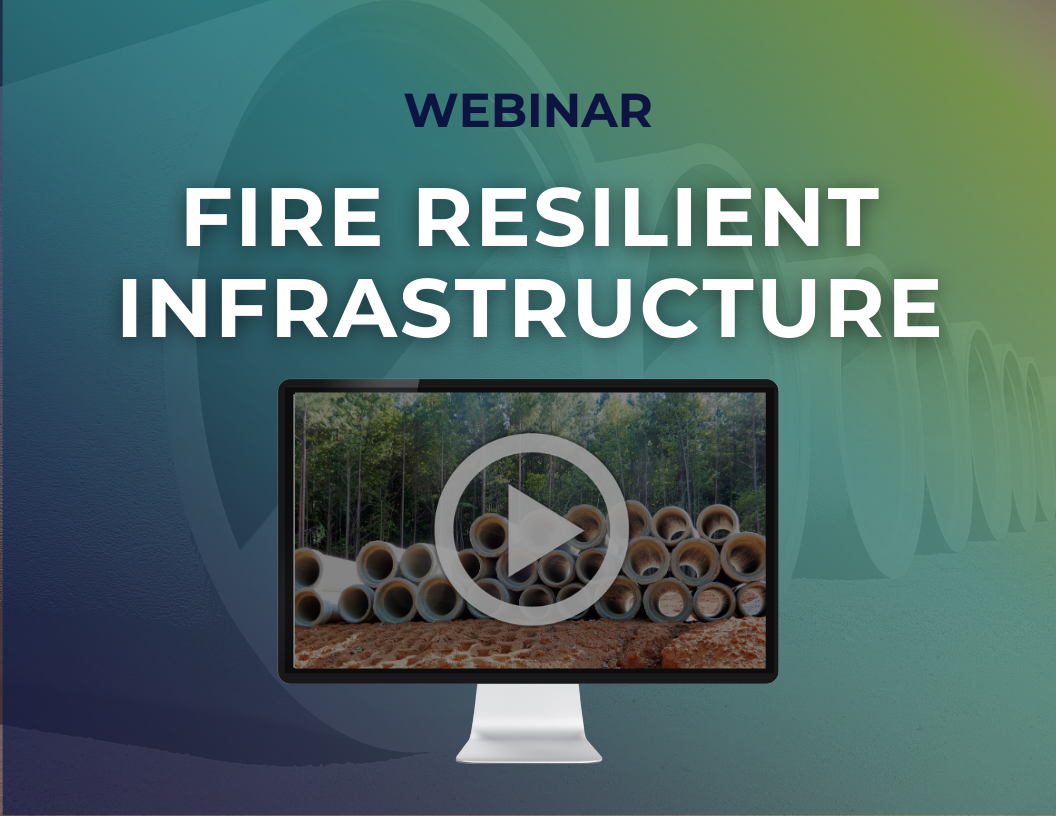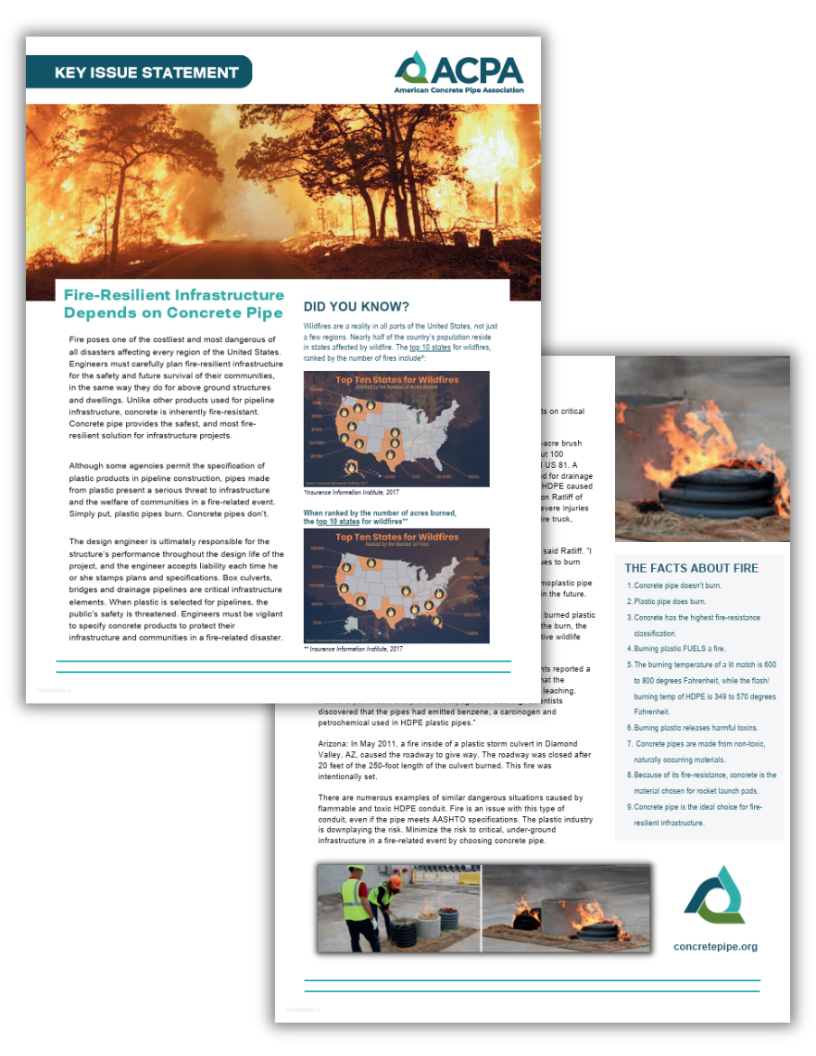
Fire
Preparing for Fire
Fires can happen almost anywhere. How can we prepare for the worst?
Across the United States, wildfires and other fire-related disasters pose significant threats to infrastructure. With nearly half the population living in wildfire-prone states, the choice of materials for critical infrastructure becomes a matter of public safety and fiscal responsibility. Concrete pipe, known for its non-flammability and durability, offers a safe and sustainable solution.
The Concrete Advantage
Concrete pipe offers unparalleled advantages for fire-resilient infrastructure. Its non-flammable nature ensures it remains intact during wildfires and other high-temperature exposures, preventing the collapse of crucial transportation routes allowing for transport of families and emergency personnel during fire events. Moreover, concrete pipe does not release toxic chemicals in fire situations, safeguarding both the environment and public health. This combination of durability, safety, and environmental protection makes concrete pipe the definitive choice for responsible infrastructure development.

WATCH
Fire Resilient Infrastructure Webinar
Watch this complimentary webinar and hear firsthand the findings from the 2018 Camp Fire and learn about the process the California Regional Quality Water Control Board used to replace 66 damaged plastic and metal pipe culverts with concrete pipes.
The Threat of Fire to Infrastructure
Fire poses one of the most destructive challenges to infrastructure, impacting safety, environmental health, and community resilience. Unlike plastic pipes, which can exacerbate fire damage by melting and releasing toxic chemicals, concrete pipes do not burn, melt, or emit harmful substances. This inherent resistance to fire makes concrete pipe a trusted material for safeguarding essential evacuation routes and public utilities.
Proven Resilience in Real-World Disasters
Instances of catastrophic infrastructure failure during fire events highlight the vulnerability of plastic pipes. For example, during wildfires in Texas and California, the melting of plastic culverts led to road collapses and environmental damage. Concrete pipe's ability to withstand high temperatures preserves the integrity of roads and utilities, ensuring they remain operational when needed most.
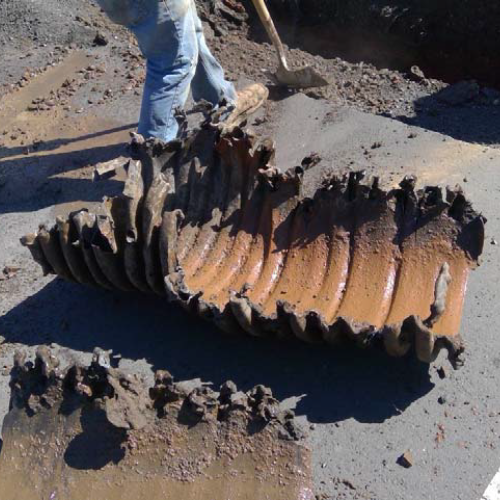
The Liability of Choosing Inferior Materials
Choosing materials that are prone to fire-related failures not only risks public safety but also increases liability for engineers and decision-makers. With concrete pipe, engineers can design infrastructure with confidence, knowing it will perform as expected throughout its intended lifespan, even in fire-prone areas.
Concrete Pipe: The Choice for Fire-Resilient Infrastructure
Federal, state, and local agencies recognize the importance of building infrastructure that can withstand the test of time and disaster. Concrete's highest fire-resistance classification and its non-toxic composition make it the ideal choice for building resilient, fire-safe infrastructure.
Discover the Unrivaled Benefits of Concrete Pipe
The ultimate solution in strength, resilience, and sustainability. Trust in infrastructure that stands the test of natural disasters and time. Robust, enduring, and eco-friendly, concrete pipe is the definitive choice for building strong and sustainable infrastructure.
What to learn more about concrete pipe? Learn why concrete pipe is the only choice.
Additional Resources
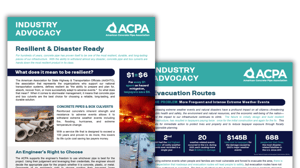
Concrete is the material of choice when it comes to being disaster ready. Download the handout to learn more.
DOWNLOAD HANDOUT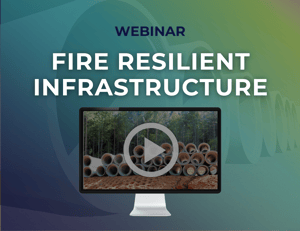
Hear the findings from the 2018 Camp Fire and the process used to replace damaged plastic & metal pipes with concrete pipes.
WATCH WEBINAR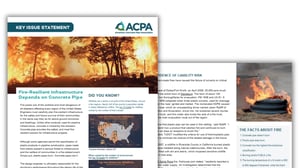
Concrete pipe provides the safest, and most fire-resilient solution for infrastructure projects. Watch video and learn more.
DOWNLOAD HANDOUT

